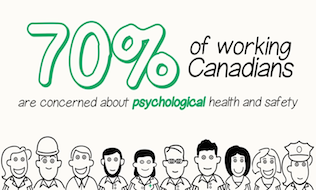

The Mental Health Commission of Canada and Ottawa Public Health have partnered to launch a series of free animated videos for employers and employees on psychological health and safety in the workplace.
The first six videos are now available with seven more to follow, each one covering a different factor in the National Standard for Psychological Health and Safety in the Workplace. The standard, which was developed by the Bureau de Normalisation du Quebec and CSA Group, focuses on 13 factors that influence psychological health and safety in the workplace.
“They are the kind of things that you see addressed in those first six videos: organizational culture, the psychological demands of work, clear leadership, civility and respect,” says Ed Mantler, vice-president, programs and priorities at the Mental Health Commission of Canada. “None of these are a silver bullet to making better workplaces, but addressing all 13 factors over time is really what promotes psychological health and safety in the workplace.”
Read: Starbucks Canada increases mental-health benefits to $5,000
Since the national standard and its implementation guide were made available in 2013 it’s had phenomenal uptake, says Mantler, with more than 30,000 downloads. The commission is currently working closely with 40 organizations of different sizes and from different sectors all across Canada on a case study project, the results of which will be published in the spring of 2017.
But one of the pieces of feedback the commission has received, according to Mantler, is that the standard’s 13 factors are sometimes difficult to understand. “When employers are just beginning to look at the standard or have conversations with their staff, having a really good understanding of the 13 psychological factors is so important, but it’s not intuitive knowledge.
“The videos are really a way, in a very brief amount of time, to give a good definition of what the factor is and walk through, in a very pragmatic way, what that factor might look like in a workplace, highlighting a workplace culture where the factor is not being promoted, in the hopes that some organizations or employees might be able to recognize themselves. And doing it in a way that’s a little bit fun and easy to watch,” says Mantler.
Read: How psychologically healthy are your employees?
“It gives some tips about what employers and employee groups might do to address that standard in the workplace. It’s really meant as a way of raising awareness, sharing a bit of information and mostly igniting a conversation about what can happen in any given workplace around that particular standard.”
This week, the Centre for Addiction and Mental Health is urging the Trudeau government to make mental health a top priority as it negotiates a new health accord with the provinces and territories. Dr. Catherine Zahn, the centre’s president, said mental illness afflicts roughly 20 per cent of Canada’s population and costs the economy an estimated $51 billion each year.
Mantler echoes this sentiment, noting that one in five Canadians will experience a mental-health difficulty or illness this year. “That means that this week in Canada half a million people have called in sick to work because of a mental-health problem,” he says. “That has a significant economic bearing on our workplaces and, in fact, about 30 per cent of disability claims, accounting for about 70 per cent of disability claims are related to mental health within the workplace.
“Addressing psychological health and safety in the workplace makes economic sense, it’s good for businesses, it’s good for employers, it’s good for employees.”
Read: Treating mental health could boost Canadian economy by $48B a year
